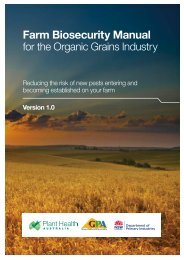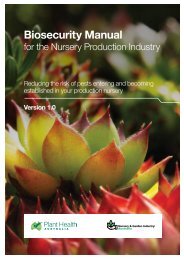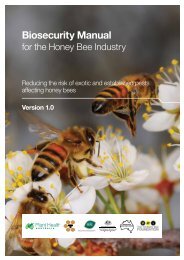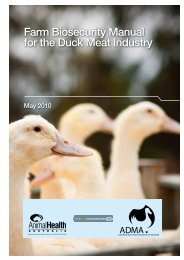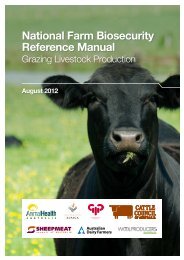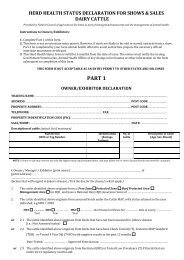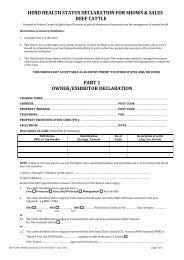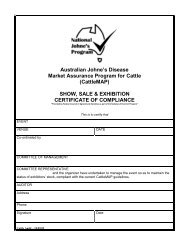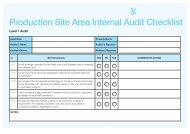Orchard Biosecurity Manual for the Mango Industry - Farm Biosecurity
Orchard Biosecurity Manual for the Mango Industry - Farm Biosecurity
Orchard Biosecurity Manual for the Mango Industry - Farm Biosecurity
You also want an ePaper? Increase the reach of your titles
YUMPU automatically turns print PDFs into web optimized ePapers that Google loves.
Damaged fruit may be attacked secondarily by fruit<br />
flies or various decay organisms and may fall from <strong>the</strong><br />
tree prematurely.<br />
To inspect fruit <strong>for</strong> RBMC, cut it open to expose <strong>the</strong><br />
inside of <strong>the</strong> seed. The larvae will most likely be seen<br />
tunnelling in <strong>the</strong> seed, but can also be present in <strong>the</strong><br />
flesh.<br />
How does it spread?<br />
RBMC is spread through movement of infested plant<br />
material.<br />
Where is it now?<br />
RBMC exists in India, Burma, <strong>the</strong> Philippines,<br />
Indonesia and Papua New Guinea. It may be more<br />
widely distributed in South-East Asia than records<br />
indicate. Since 1990 it has been detected on several<br />
Torres Strait Islands and is now known to occur at<br />
several locations near <strong>the</strong> nor<strong>the</strong>rn tip of Cape York<br />
Peninsula, but it has not reached any commercial<br />
mango plantations.<br />
How can I protect my orchard from<br />
Red banded mango caterpillar?<br />
Keep watch <strong>for</strong> this pest during <strong>the</strong> fruiting period<br />
and advise <strong>Biosecurity</strong> Queensland of any suspected<br />
infestation. Due to <strong>the</strong> isolation of RBMC detections<br />
on Cape York Peninsula and <strong>the</strong> Torres Strait, it<br />
poses no immediate threat to <strong>the</strong> mango industry.<br />
The detections should also not affect national<br />
or international trade from commercial mango<br />
production areas. <strong>Biosecurity</strong> Queensland regularly<br />
surveys Cape York Peninsula <strong>for</strong> RBMC and o<strong>the</strong>r<br />
mango pests.<br />
If you see anything unusual, call <strong>the</strong><br />
Exotic Plant Pest Hotline<br />
EXOTIC PLANT PEST HOTLINE<br />
1800 084 881<br />
To inspect fruit <strong>for</strong> RBMC, cut it open to expose <strong>the</strong> inside of<br />
<strong>the</strong> seed<br />
Darkened borehole on <strong>the</strong> fruit caused by entering larvae<br />
Liquid exudate shows up as a dark streak on <strong>the</strong> skin leading<br />
to a dark spot at <strong>the</strong> fruit tip<br />
For more in<strong>for</strong>mation visit www.plan<strong>the</strong>althaustralia.com.au<br />
DEEDI PaDIL (Lindsay Chandler)<br />
PaDIL (Lindsay Chandler)



